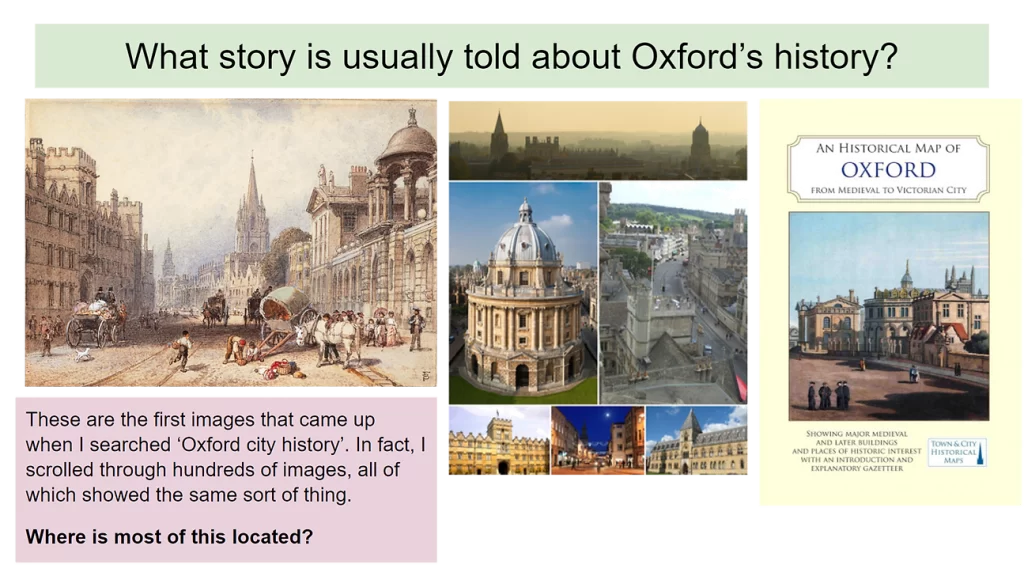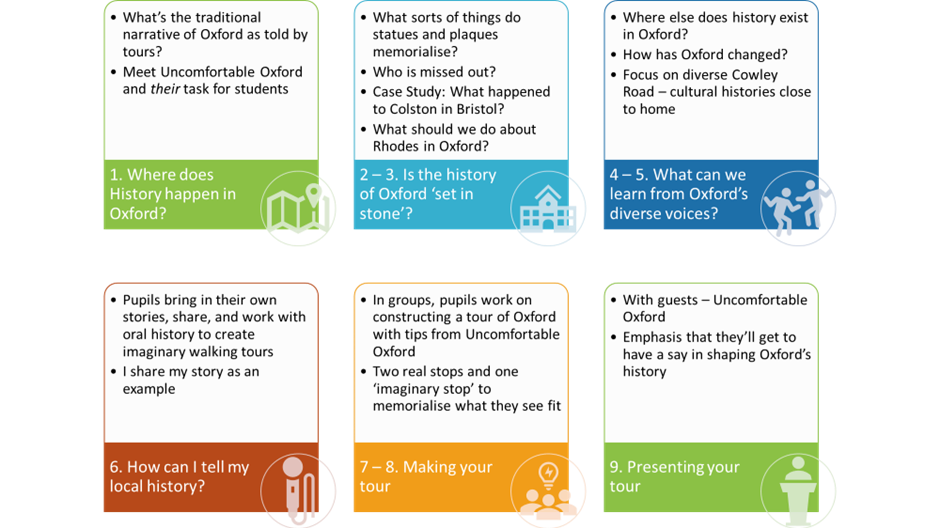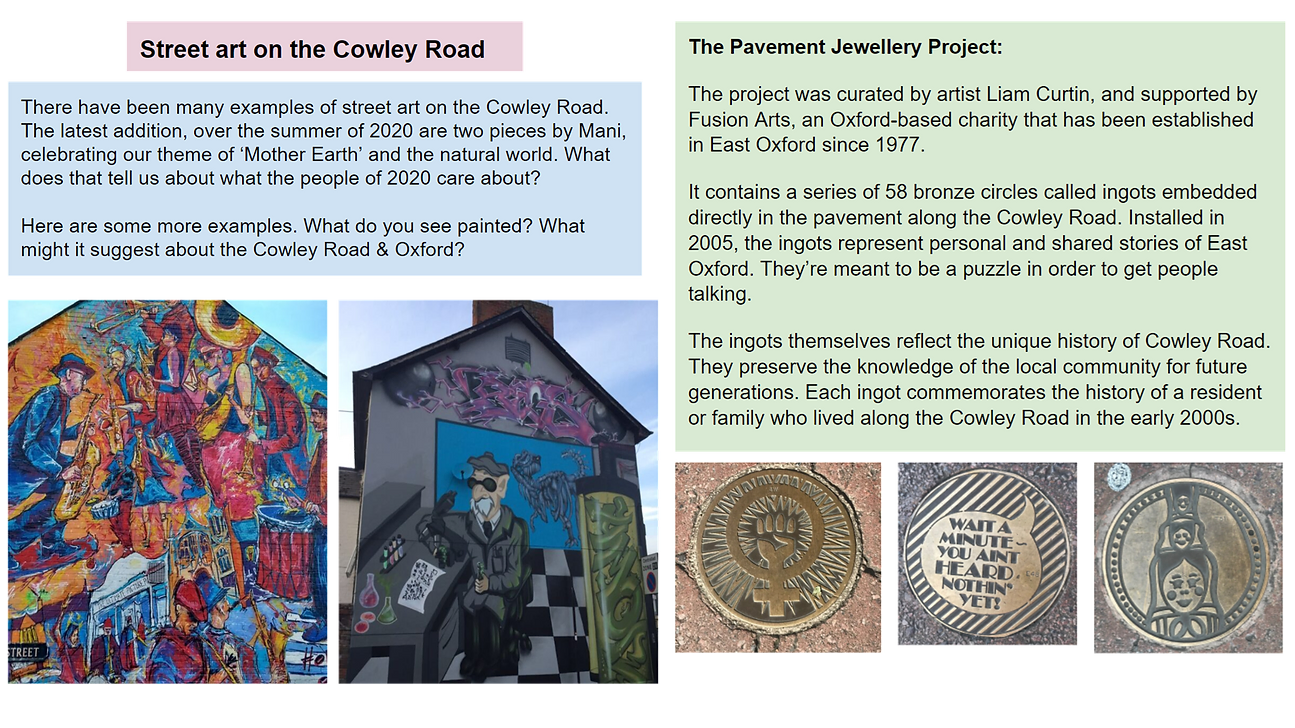As a fairly recent arrival to Oxford, if I had been asked what made the city historical, I would have probably mentioned the dreaming spires of its university buildings or the honey-hued cobblestone streets once frequented by the likes of CS Lewis and TS Eliot. I’d likely have imagined a wizened, robe-clad professor passing age-old knowledge on to eager pupils scratching away on parchment with feather quills. These are images which draw people to Oxford and are very much valid answers to the question of Oxford’s history.
Yet those who Oxford’s world-class reputation has attracted to migrate here – to live, work, or visit – have not always conformed to these stereotypes As a history teacher in a vibrantly diverse Oxford school, made up of pupils whose parents hailed from countries across the globe and from a range of socioeconomic backgrounds, I wondered how my pupils could make sense of their place within a narrative that so often ignored the ‘town’ in favour of the ‘gown’.

That these are the stories most often favoured, is reflective of patterns of injustice beyond Oxford’s borders. As illuminated by movements such as ‘why is my curriculum white?’ or, more recently, the Black Lives Matter protests in the wake of the murder of George Floyd, history curricula in Britain tend to focus on a narrow subset of society, often white, male, and middle-class. This had been inculcated into my students too. They had felt that history ‘happened’ in the city centre, and gave little value to history in their own communities.
Evidently, despite sitting side-by-side across from me every day, only a handful of students had their identities validated by their history curriculum. Evidence shows that patterns of erasure from the curriculum lead to endemic silencing and marginalisation that pupils carry beyond schooling. Professor bell hooks, in her wonderful Teaching to Transgress, reminds us that ‘students in public institutions, mostly from working-class backgrounds, come to college assuming that professors see them as having nothing of value to say, no valuable contribution to make to a dialectical exchange of ideas’. I felt that my role as a teacher was to create a space that truly valued and cared for all my pupils, giving them the confidence and authority to participate in history in my classroom and beyond. Fortunately, bell hooks offers us hope; ‘the academy is not paradise, but learning is a place where paradise can be created’.[1] Her words are a beautiful reminder that the classroom can be a vehicle for change, a site of possibility, and a space for transformation.
Whilst I was clear on these aims, and the need to bring to the fore alternative narratives of Oxford’s history, I had to ensure the lessons were also historically rigorous. My patchy knowledge of Oxford’s history, coupled with my prohibitively busy teacher schedule, prompted me to reach out to Uncomfortable Oxford. Together, we planned a series of nine one-hour lessons, centred around the overarching question, ‘What stories can we tell of Oxford’s history?’ At the end of the nine lessons, students were tasked with giving their own tours of Oxford, helped by – and presented to – myself and the Uncomfortable Oxford team. The intervening lessons were spent exploring various narratives of Oxford’s history, from central Oxford to the diverse Cowley Road, from plaques to street art, and from written sources to oral history interviews which pupils brought with them from home.

The lessons surpassed my expectations. Students were brimming with enthusiasm. At least in part, this came from our efforts to make sure the lessons were meaningful. Involving Uncomfortable Oxford, as an outside organisation, gave palpable significance to pupil work. The students were given the opportunity to add their voice to the public debates around the role of statues ignited at the time by the toppling of the monument to slave trader Edward Colston in Bristol. We explored this and the controversial statue of Cecil Rhodes before writing individual letters to Lord Mendoza of Oriel College. Public debates often happen in echelons beyond students’ grasp as academics, social commentators, and politicians are invited to speak. But as I witnessed young people caring very deeply about the statue, the debates seemed to take on a new meaning. One student wrote, ‘As someone who lives in Oxford and walks by the statue almost every day, I think it is important that my voice is heard.’ I’m sure you can imagine our excitement when Lord Mendoza wrote us a reply!
Many chose to use their tours of Oxford to express matters they cared about. They were asked to work in groups to come up with three stops, two of which were existing places, and the third an ‘imaginary stop’ to memorialise as they saw fit. These examples give you a snapshot of student responses: a tour in which the participants would collect some oral histories about Oxford themselves by travelling along the diverse Cowley Road; a tour focused on LGBTQ+ history which began with visiting the school site where relevant graffiti had been chalked by students across the school during a sixth-form-organised LGBTQ+ awareness day; a project honouring protestors throughout Oxford’s history, in the wake of marches in support of Palestine and the BLM protests; a community garden designed as a living museum, where members of the public could collect seeds to plant named after past and present environmentalists from the city.

My collaboration with Uncomfortable Oxford was fruitful in so many ways. As a busy, tired teacher, I appreciated their help with the work of unearthing hidden voices. They helped to ensure there was rigorous historical grounding, teaching me about collecting oral histories and writing narratives for history tours. Pupils were able to make use of their newfound and sophisticated knowledge of how history operates, and how to look for gaps and silences in later topics we studied.
Through carefully crafting a meaningful series of lessons, pupil engagement in my classroom reached unprecedented levels. I was astonished when three young boys whom I had struggled to engage for the best part of a year asked me if they could take their tours home to complete for homework! I’ll leave the last word to a colleague, who texted me in excitement when he experienced the very rare occurrence that every single one of the pupils in his class brought in their homework, which was to collect a piece of oral history from home:
‘They all brought in their homework! There were kids from Poland, East Timor, China, Surrey, Indonesia, India, Pakistan, Romania, Cowley, the Philippines, Sudan, Barton and more. All of them sharing their heritage and what’s important to them and their families. If you are trying to make them feel represented by the curriculum then you are succeeding!’
Written by Zaiba Patel
This post is part of our Uncomfortable Education series, which seeks to provide resources for those teaching the histories of challenging and contentious topics.
References
[1] bell hooks, Teaching to Transgress (1994), p. 149.





